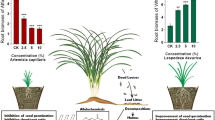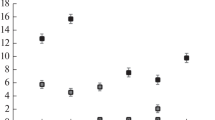Abstract
Polygonum aviculare was observed to spread rapidly into heavy stands ofCynodon dactylon (L.) Pers. resulting in death of the latter. This indicated a strong interference againstCynodon dactylon. Measurements of selected soil minerals and physical factors indicated that competition was probably not the chief cause of that interference. Soil collected under deadPolygonum was very inhibitory to all test species exceptSporobolus pyramidatus (Lam.) Hitchc., suggesting the presence of inhibitory compounds. Tops and roots ofPolygonum, root exudates, and leachate of the tops inhibited seed germination and seedling growth of most test species. Therefore, allelopathy apeared to be the dominant component of the interference, with competition probably accentuating its effects.Polygonum aviculare was inhibitory toGossypium barbadense L. andSorghum bicolor (L.) Moench, indicating that allelopathy is an important component of the interference byPolygonum against crop yields.
Similar content being viewed by others
References
Anderson, R.C., Katz, A.J., andAnderson, M.R. 1978. Allelopathy as a factor in the success ofHelianthus mollis Lam.J. Chem. Ecol. 4:9–16.
Bell, D.T., andKoeppe, D.E. 1972. Noncompetitive effects of giant foxtail on the growth of corn.Agron. J. 64:321–325.
Bhowmik, P.C., andDoll, J.D. 1979. Evaluation of allelopathic effects of selected weed species on corn and soybeans.Proc. North Central Weed Conf. 34:43–45.
Bouyoucos, G. 1936. Direction for making mechanical analysis of soils by the hydrometer method.Soil Sci. 42:255–229.
Bremner, J.M. 1965. Total nitrogen, pp. 1149–1178,in C.A. Black, (ed.). Methods of Soil Analysis, Part 2. American Society of Agronomy, Inc., Madison, Wisconsin.
Colton, C.E., andEinhellig, F.A. 1980. Allelopathic mechanisms of velvetleaf (Abutilon theophrasti Medic., Malvaceae) on soybean.Am. J. Bot. 67(10):1407–1413.
Hoagland, D.R., andArnon, D.I. 1950. The water culture method for growing plants without soil.Calif. Agr. Exp. Sta. Cir. 347.
Holm, L., Pancho, J.V., Herberger, J.P., andPlucknett, D.L. 1979. A geographical Atlas of World Weeds. John Wiley, New York.
Horowitz, M., andFriedman, T. 1971. Biological activity of subterranean residues ofCynodon dactylon L., Sorghum halepense L., andCyperus rotundus L.Weed Res. 11:88–93.
Hull, J.C., andMuller, C.H. 1977. The potential for dominance byStipa pulchra in California grassland.Am. Midl. Nat. 97:147–175.
Jordan, T. N. 1977. Effects of temperature and relative humidity on the toxicity of glyphosate to bermudagrass (Cynodon dactylon).Weed Sci. 25:448–451.
Newman, E.I., andRovira, A.D. 1975. Allelopathy among some British grassland species.J. Ecol. 63:727–737.
Perkin-Elmer, 1976. Analytical Methods for Atomic Absorption Spectrophotometry. Norwalk, Connecticut.
Piper, C.S. 1942. Soil and Plant Analysis. The University of Adelaide, Adelaide, Australia 368 pp.
Rasmussen, J.A., andRice, E.L. 1971. Allelopathic effects ofSporobolus pyramidatus on vegetational patterning.Am. Midl. Nat. 86:309–325.
Rice, E.L. 1979. Allelopathy-an update.Bot. Rev. 45:15–109.
Shelton, W.R., andHarper, H.J. 1941. A rapid method for the determination of total phosphorus in soil and plant material.Iowa State Coll. J. Sci. 15:408–413.
Tames, R.S., Gesto, M.D.V., andVieitez, E. 1973. Growth substances isolated from tubers ofCyperus esculentus var.aureus. Physiol. Plant. 28:195–200.
Tubbs, C.H. 1973. Allelopathic relationship between yellow birch and sugar maple seedlings.For. Sci. 19:139–145.
Wilson, R.E., andRice, E.L. 1968. Allelopathy as expressed byHelianthus annuus and its role in old field succession.Bull. Torrey Bot. Club 95:423–448.
Author information
Authors and Affiliations
Rights and permissions
About this article
Cite this article
Alsaadawi, I.S., Rice, E.L. Allelopathic effects ofPolygonum aviculare L. I. Vegetational patterning. J Chem Ecol 8, 993–1009 (1982). https://doi.org/10.1007/BF00987881
Received:
Revised:
Issue Date:
DOI: https://doi.org/10.1007/BF00987881




